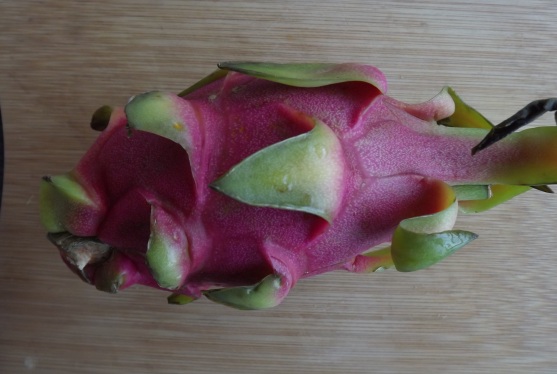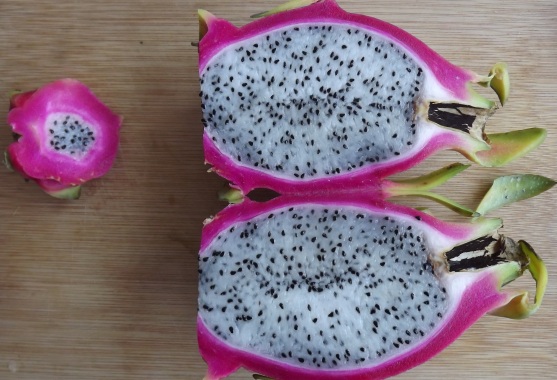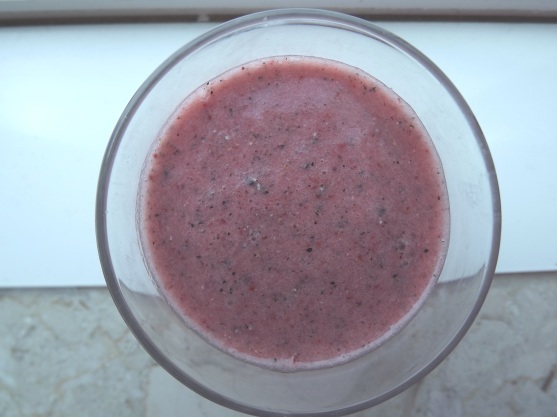Name: Pithaya, commonly known by its English name of dragon fruit.
Appearance: Its name may sound almost as ferocious as the snake fruit I taste-tested last month, but wherever the dragon fruit gleaned its mythological connotations, it was certainly not from its appearance. With its vivid magenta skin – the same synthetic pink as an 80’s lipstick – and green spikes, the dragon fruit looks a bit like a pineapple going through an emotional teen punk phase.
When I slit open the fruit – carefully hulling it first, although I don’t think this is necessary – I discover white, fibrous flesh, flecked with black seeds. I immediately recoil – I have an irrational fear of white foods, and besides, the dragon fruit’s interior reminds me irresistibly of frogspawn. Curiouser and curiouser.
Where do they eat it? Dragon fruit grow on cactuses. They probably came from Mexico originally, but today they’re cultivated and eaten across the world.
Cost and sourcing: My dragon fruit cost 4 dirhams and 80 fils. As usual, Lulu was my source (they don’t pay me an advertising fee, I swear).They’re markedly more expensive in the UK, and, as I reported in my eddoes blog, much smaller and less colourful.
Preparation: Halve your dragon fruit and scoop out the frogspawn-like flesh. This is the bit you eat. The magenta skin, while pretty, is not edible.
So, what does it taste like? When I take my first tentative bite of the dragon fruit, I’m fully prepared for a burst of tropical flavour. I’m a little puzzled, then, to find that the fruit tastes of… well… nothing. Bemused, I cut another slice – perhaps, I speculate, I’m not getting the full benefit of the fruit’s flavour because it has recently emerged from my fridge – but even after eating a quarter of it, I still can’t taste anything. Only a slightly sweet aftertaste indicates that I have indeed been eating a tropical fruit.
Texture-wise, the fruit is probably most similar to a kiwi, and it’s pleasingly juicy. A good candidate for a long hot afternoon, but then so is a glass of water, frankly.
So, what did you do with it? The dragon fruit is so bland that I figure it could be paired with pretty much anything, so I decide to add it to a smoothie. I blitz the remainder of the dragon fruit flesh with a handful of frozen strawberries and a ripe banana. The dragon fruit’s high water content has the benefit of lending my smoothie a looser texture than those I’ve made in the past. Strangely, it also has the effect of diminishing the sweetness of the banana and the tartness of the strawberries. For the first time, I can actually taste something – a very delicate, not unpleasant floral flavour, almost like I’d thrown a head of cut flowers into the blender along with the other fruit. The dragon fruit’s many seeds, meanwhile, add an interesting dynamic to the smoothie’s texture.
Verdict: 2/5
The dragon fruit is like the hipster you meet at a party who has a red Mohawk and a sleeve of unexplainable tattoos, but who has nothing of interest to say once you’ve gotten past his tough exterior. I’m not sure I would buy it again, not even to add to my morning smoothie. For UK readers, the quality of the fruit available over there is too low to justify the hefty price tag. Stick with a glass of water.



